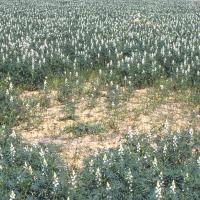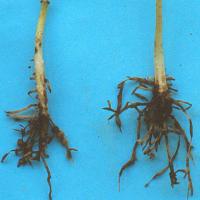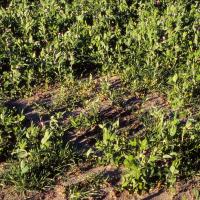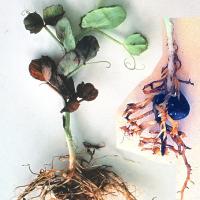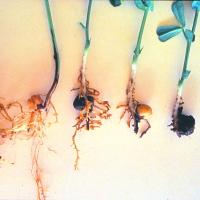Diagnosing rhizoctonia bare patch in grain legumes
Rhizoctonia bare patch ( Rhizoctonia solani ) occurs on most soil types throughout the wheatbelt and causes similar patches in all crop and pasture species. All varieties and species of lupin are equally susceptible.
What to look for
- Distinct patches of stunted or dying plants that start to show 4-6 weeks after sowing.
- Patches are roughly circular with a diameter varying from 0.5 m to 5m that may be elongated in the direction of sowing.
- Almost no yield within the patches.
- Weeds within the patch are usually also affected.
Paddock
- Tap and lateral roots of stunted plants are pinched off by characteristic dark brown spear-tipped lesions. Roots may look stubby when soil is still attached.
- As the season progresses damaged plants often die.
Plant
What else could it be
| Condition | Similarities | Differences |
|---|---|---|
| Diagnosing Eradu patch in narrow-leafed lupins | Patches of stunted and dying plants. | Eradu patch causes brown lesions that also pinch root ends and strip the root cortex, rather than dark brown spear tip pinched roots. |
Where did it come from?
- Rhizoctonia bare patch has a wide host range and is as damaging to cereal and pasture species as it is to lupins.
- The fungus survives between seasons as tough hyphae in crop debris or in particles of soil organic matter that it has colonised.
- It is stimulated to grow in the following season once the soil becomes moist
- Rhizoctonia bare patch is most severe in crops established with zero or minimum tillage.
Management strategies
- Rhizoctonia bare patch has a wide host range and cannot be controlled by rotating crops.
- Tillage to a depth of 10-15 centimetres (cm) at about the time of sowing reduces the number and severity of patches. Modification of seeding machinery to cultivate 5-10cm below the sowing depth will provide effective disease control in a direct drilled crops
- Patches can also be controlled by deep ripping (25-30cm) immediately before or after seeding.
- Seed or in-furrow fungicides are not yet registered for lupins.
See also
Where to go for expert help
Page last updated: Wednesday, 6 May 2015 - 3:23pm


